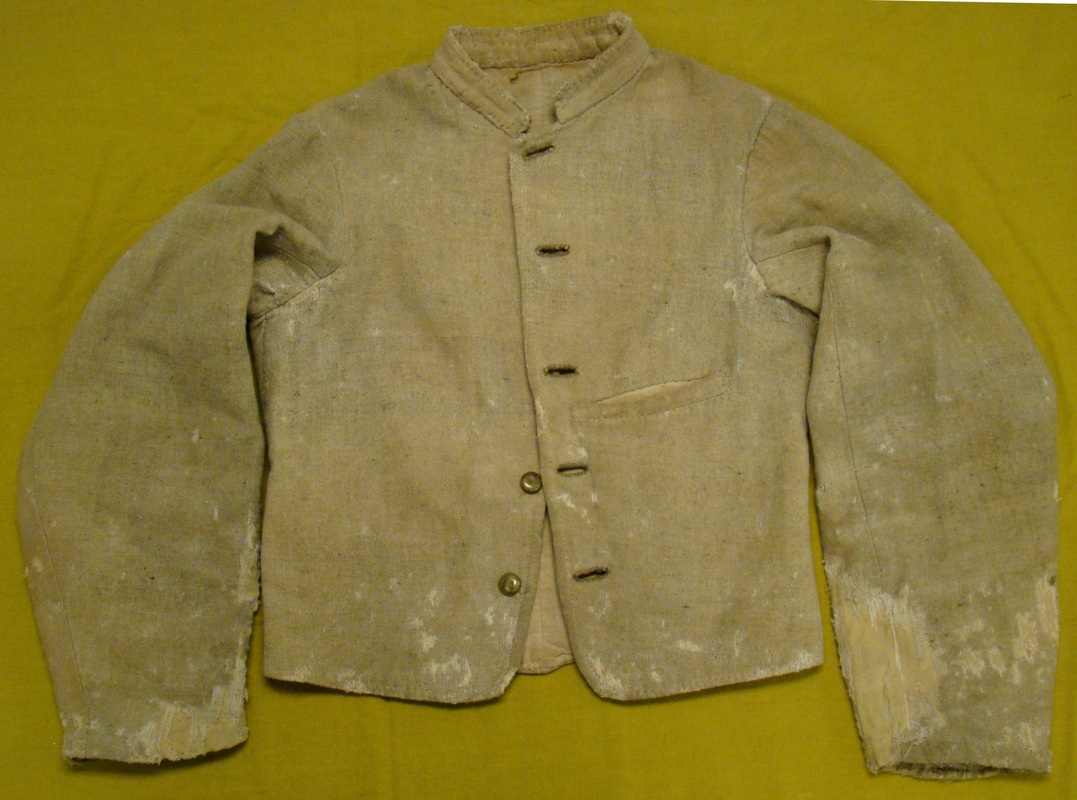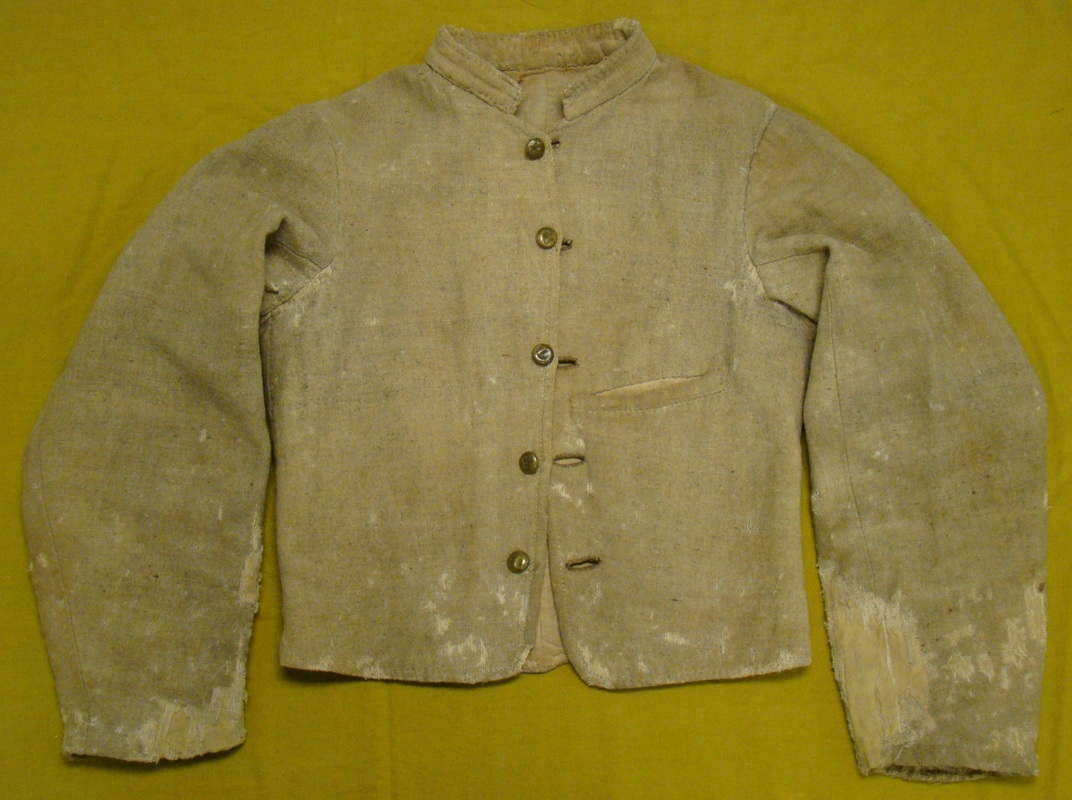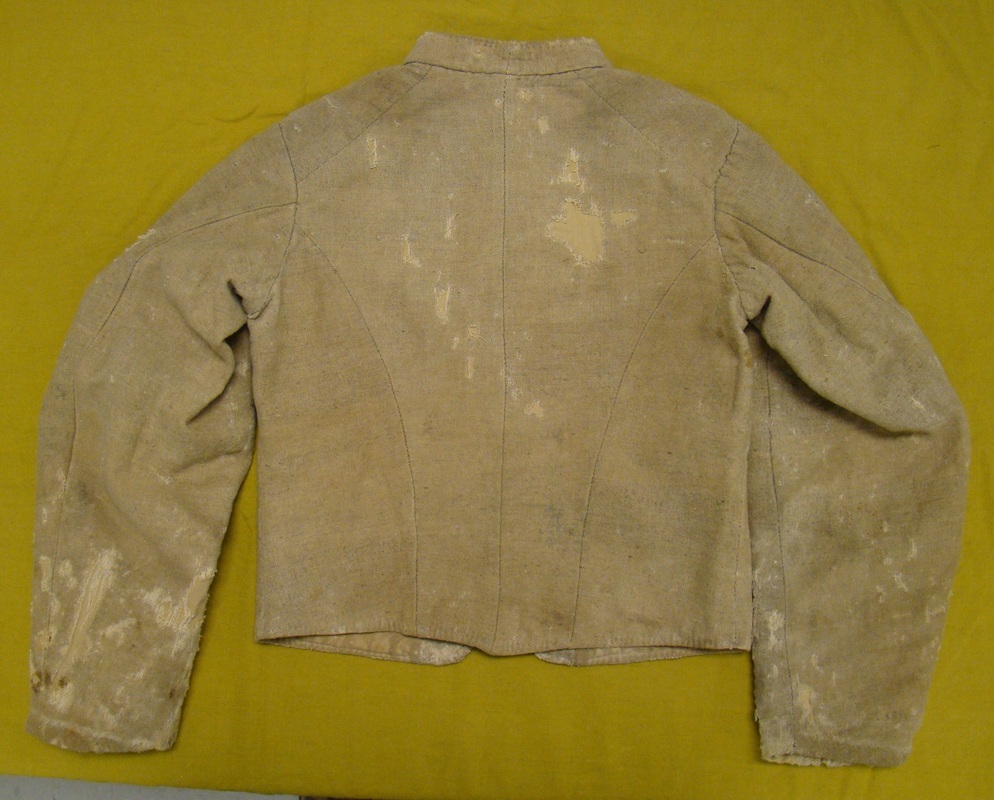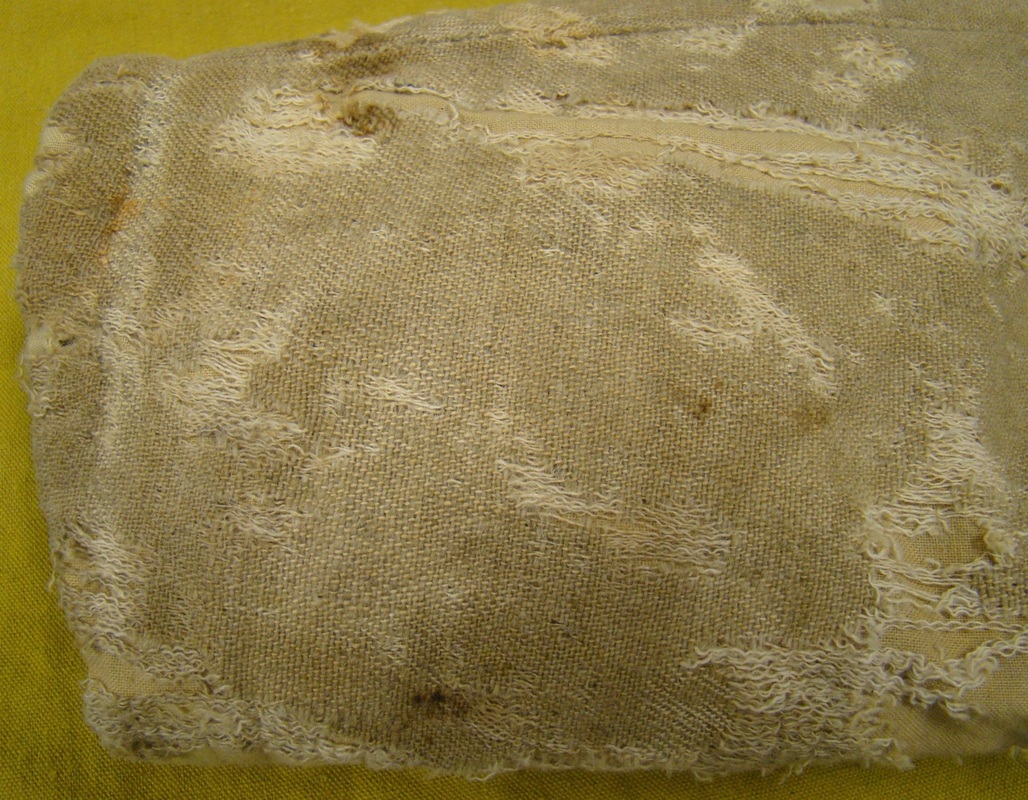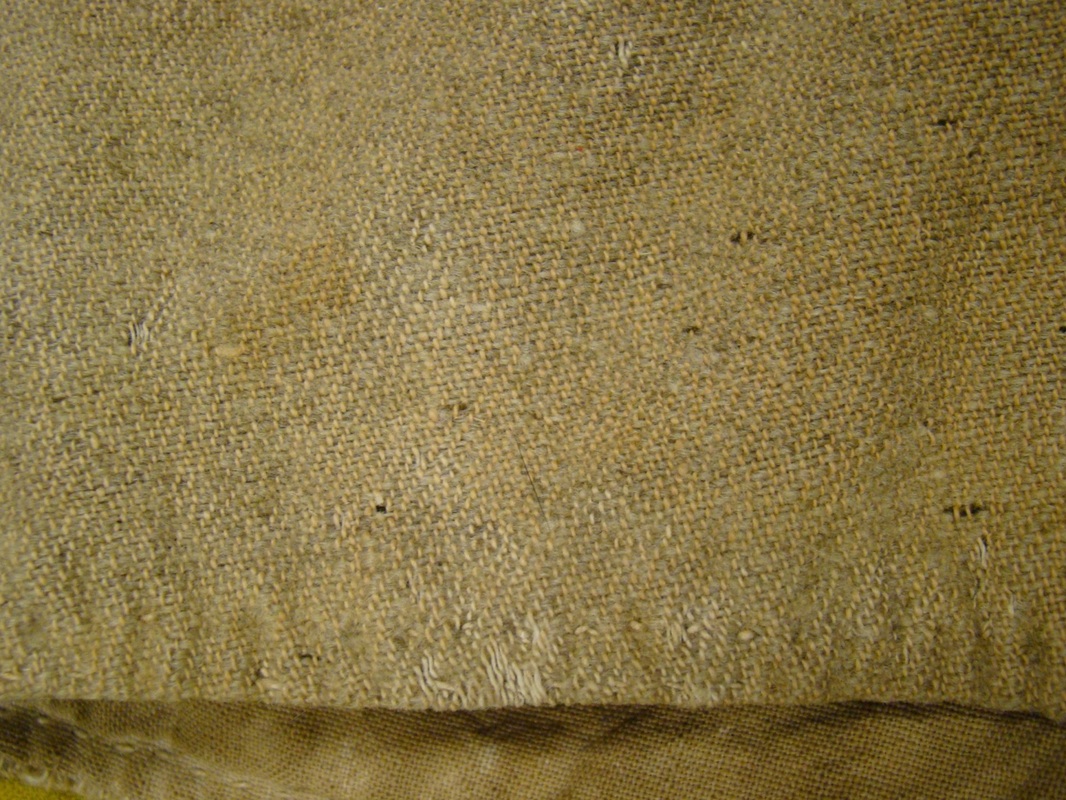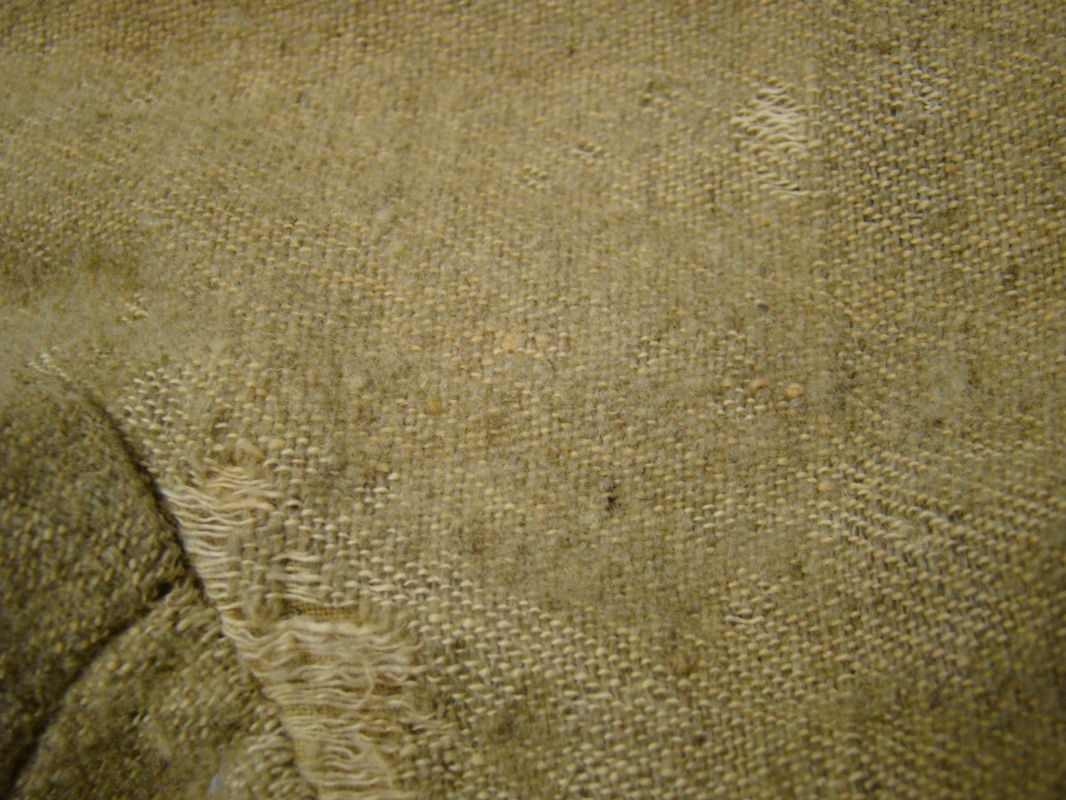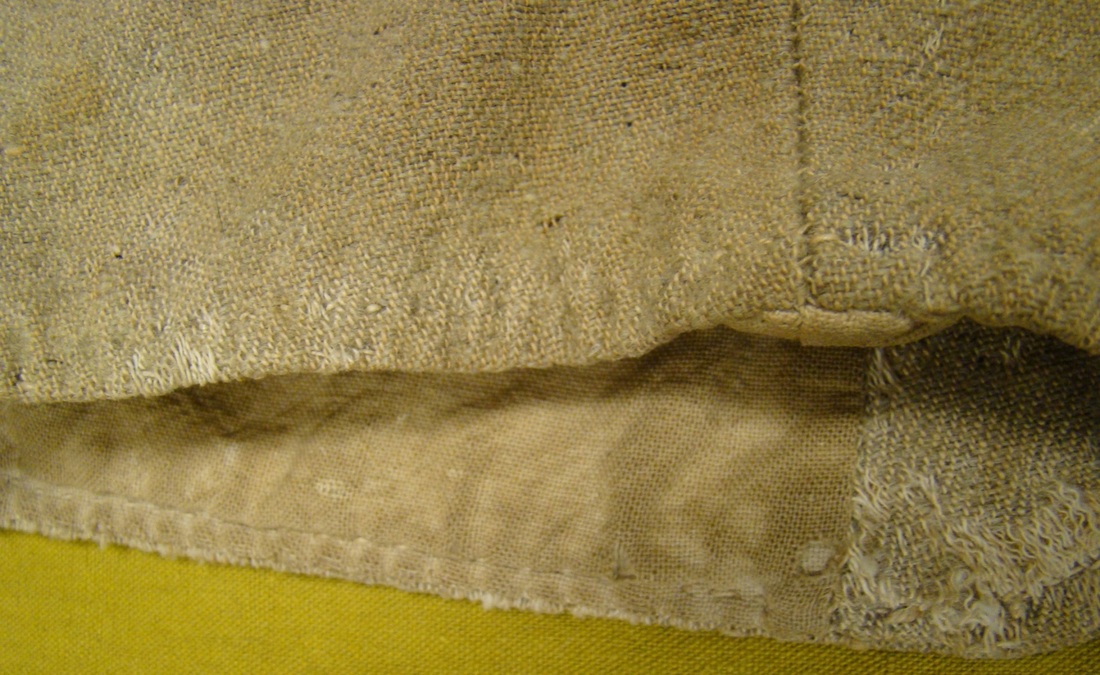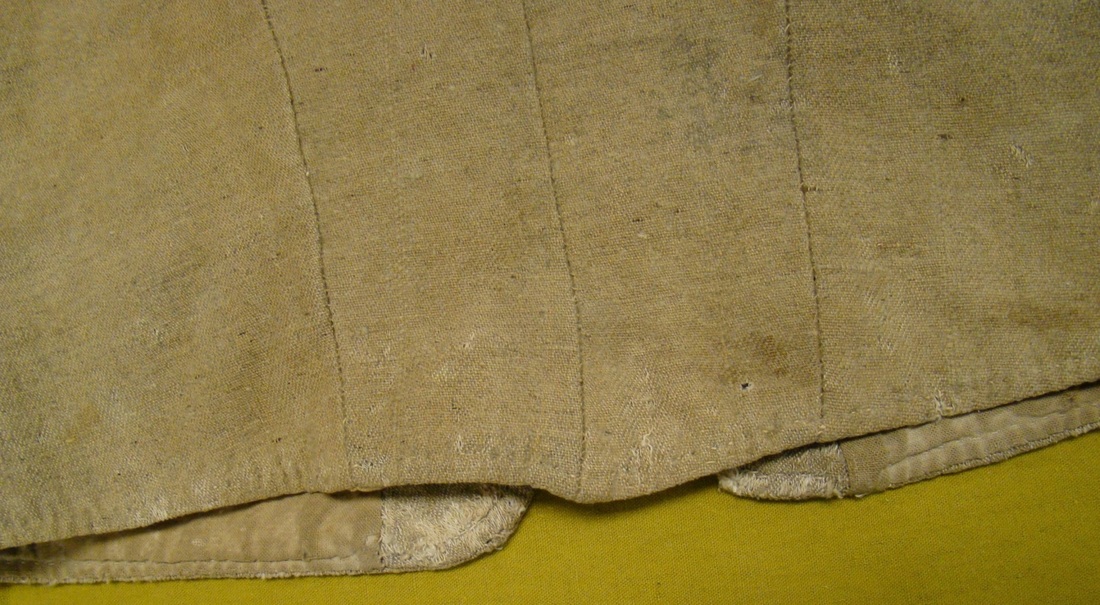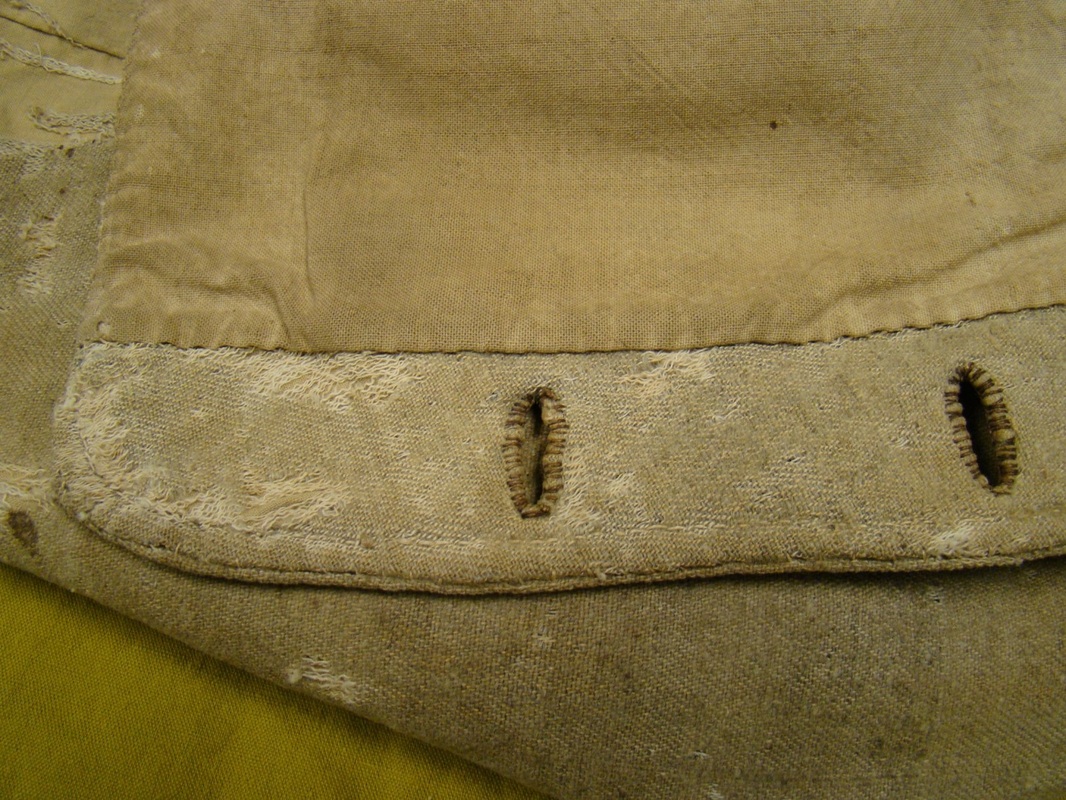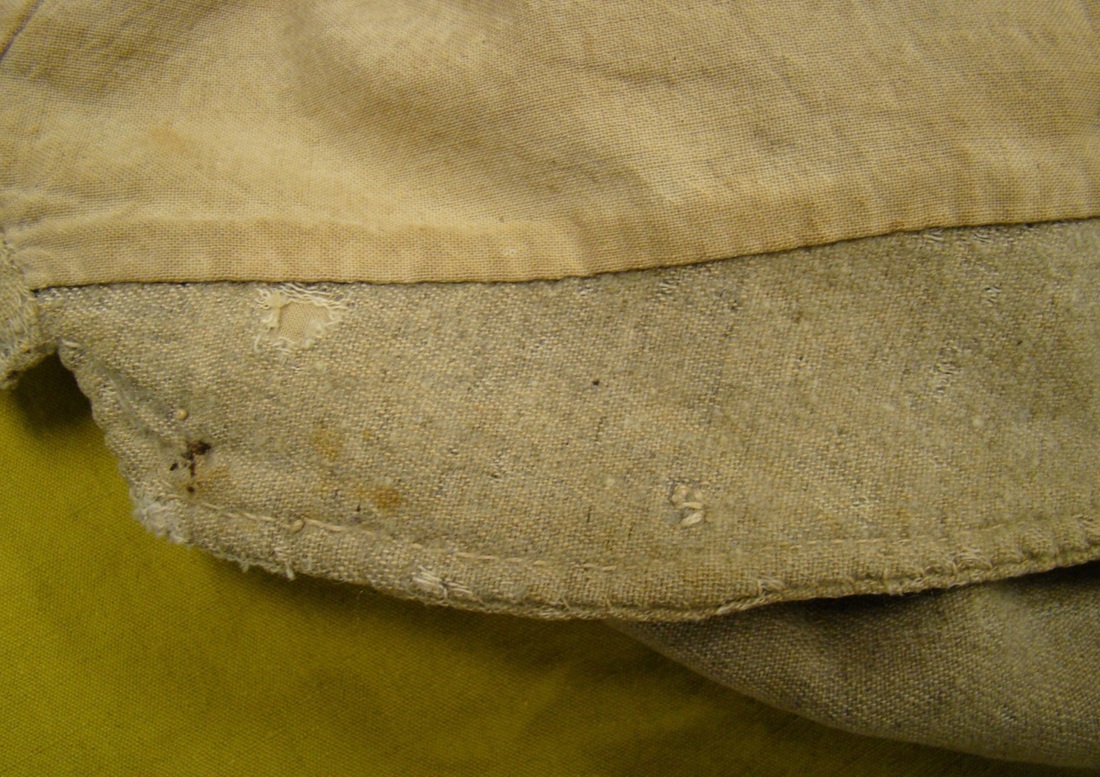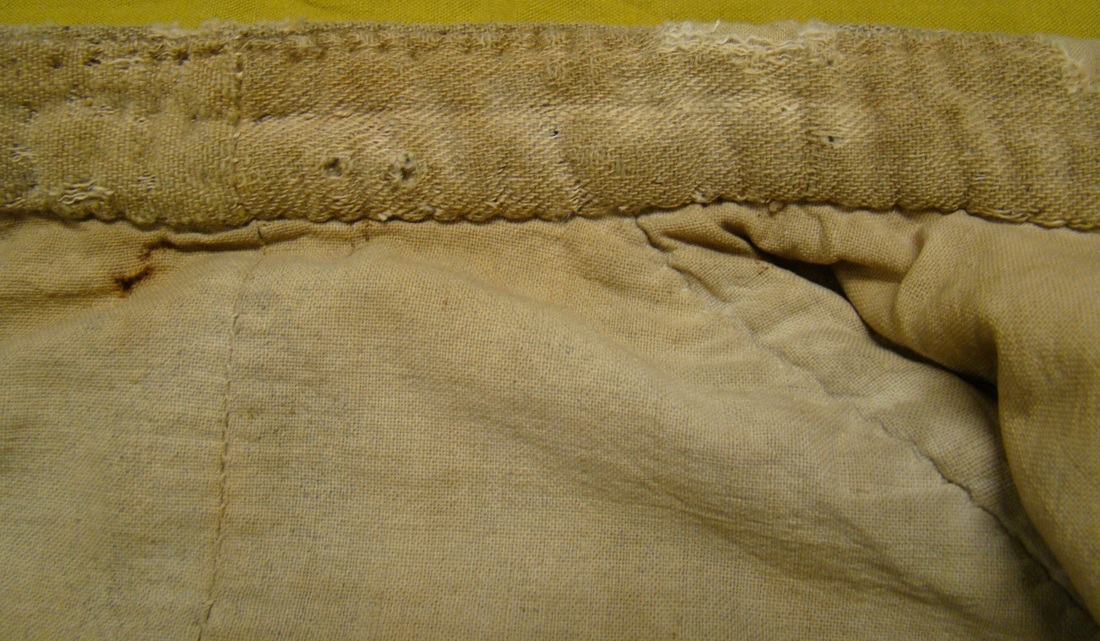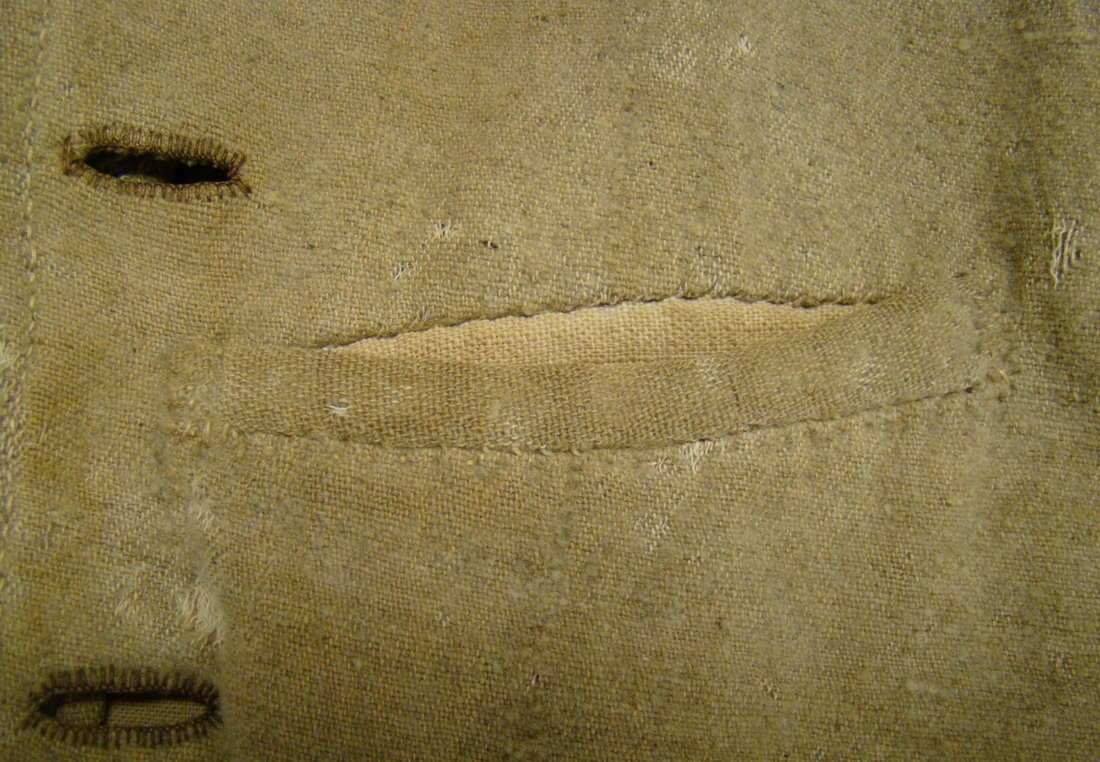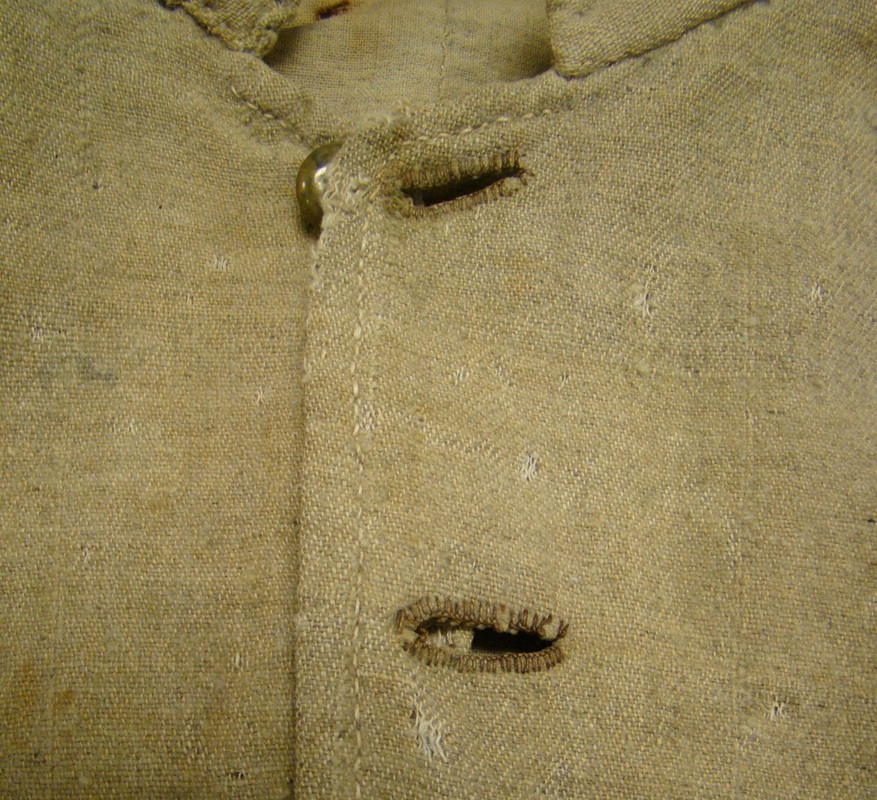Lower South Jacket of John B.L. Grizzard, Hanleiter's Georgia Light Artillery
by Fred Adolphus, 15 September 2013
Mr. Ray Richey, of the Texas Civil War Museum, Fort Worth, Texas, and Mr. Gary Hendershott of Little Rock, Arkansas, allowed access to a fascinating Lower South, Confederate depot jacket, and I was able to examine the jacket thoroughly on 9 September 2013. The jacket was worn by Private John Britten Lewis Grizzard of Fulton County, Georgia. Grizzard joined the Confederate Army in Atlanta on February 3, 1864, along with James L. Grizzard, and Simeon S. Grizzard.
The others may have been his brothers, but were certainly close relatives. All three men enlisted in Hanleiter’s Company, Georgia Light Artillery for three years. They probably chose this outfit because their relative, Thaddeus Grizzard, was already in the company, having enlisted on September 17, 1863.
Private John B. L. Grizzard served with the company from February 3rd through at least October 31, 1864. The October roll was the last to show him present: there are no later records of his service. His meager records indicate that he was absent without leave from May 27 to June 20, 1864, and that the army deducted his pay for the days he was absent. He also received clothing shortly after joining the army, on February 22, 1864. Part of that issue may have included the white woolen jacket featured in this study. Nothing else is known of his service, and he died two years after the war. He was buried at Union City, Georgia (a few miles southwest of Atlanta).
A little more is known about John’s relatives, Privates James L., Simeon S., and Thaddeus Grizzard. All three served with the company until the very end of the war. Thaddeus surrendered with Johnston’s Army at Greensboro, North Carolina, on April 26, 1865. James and
Simeon were both absent on guard duty at the Yadkin River Bridge during the surrender proceedings, but were paroled at Greensboro the same day. At least two of these Grizzards returned to the Union City area after the war, judging from cemetery records. Both James and Thaddeus were buried in the Shadnor Baptist Church Cemetery, Union City, Georgia. James L. Grizzard’s headstone indicates that he was born February 19, 1847, and died November 28, 1880. Thaddeus Grizzard’s headstone indicates that he was born April 16, 1826, and died September 3, 1892.
While the Grizzards did not join Hanleiter’s Company until later in the war, the battery was formed on June 10, 1862 from Company M, 38th Georgia Infantry. The 38th Georgia was formed with thirteen companies in the summer of 1861. The regiment moved from Fulton County, Georgia on November 6, 1861 to Savannah, arriving there on November 17th. The regiment served at Skidaway Island and Savannah until being transferred to Virginia in May 1862, except for three of the companies that were detached or transferred. Company M was one of the detached companies, and it remained in the Savannah area and reorganized as an artillery company in June. The company, commanded by Captain Cornelius R. Hanleiter, served both light and heavy guns, but for the most part light field pieces. It remained at Beaulieu, Georgia, about twelve miles below Savannah, from June 1862 until December 20, 1864. At that time, the company moved to Charleston, South Carolina, presumably along with the retreating Confederate Army. The company remained in the Charleston area through January 14, 1865. As the Confederate Army withdrew from Charleston, Hanleiter’s Light Artillery joined it, and participated in the Carolina Campaign where it fought and suffered battlefield casualties. The battery surrendered at Greensboro, North Carolina on April 26, 1865.
Regarding the jacket’s provenance, we only know the soldier who wore it and his command. We cannot say for certain when Grizzard got his jacket, where he got it, or what factory made it. It is safe to assume that the army issued the jacket to Grizzard in Georgia in 1864.
Regardless of where it was issued, perhaps Atlanta or Charleston, its place of manufacture cannot be determined. Georgia had so many small factories making uniforms for each depot, that it could have been any one of them. These factories sent their products to different depots, and the different depots sent the uniforms to commands throughout Georgia and South Carolina. Many of the surviving uniforms from the Lower South factories were undyed, natural white-colored woolen, to include those of the late war period. This jacket is very typical of what of what many Georgia factories produced.
The others may have been his brothers, but were certainly close relatives. All three men enlisted in Hanleiter’s Company, Georgia Light Artillery for three years. They probably chose this outfit because their relative, Thaddeus Grizzard, was already in the company, having enlisted on September 17, 1863.
Private John B. L. Grizzard served with the company from February 3rd through at least October 31, 1864. The October roll was the last to show him present: there are no later records of his service. His meager records indicate that he was absent without leave from May 27 to June 20, 1864, and that the army deducted his pay for the days he was absent. He also received clothing shortly after joining the army, on February 22, 1864. Part of that issue may have included the white woolen jacket featured in this study. Nothing else is known of his service, and he died two years after the war. He was buried at Union City, Georgia (a few miles southwest of Atlanta).
A little more is known about John’s relatives, Privates James L., Simeon S., and Thaddeus Grizzard. All three served with the company until the very end of the war. Thaddeus surrendered with Johnston’s Army at Greensboro, North Carolina, on April 26, 1865. James and
Simeon were both absent on guard duty at the Yadkin River Bridge during the surrender proceedings, but were paroled at Greensboro the same day. At least two of these Grizzards returned to the Union City area after the war, judging from cemetery records. Both James and Thaddeus were buried in the Shadnor Baptist Church Cemetery, Union City, Georgia. James L. Grizzard’s headstone indicates that he was born February 19, 1847, and died November 28, 1880. Thaddeus Grizzard’s headstone indicates that he was born April 16, 1826, and died September 3, 1892.
While the Grizzards did not join Hanleiter’s Company until later in the war, the battery was formed on June 10, 1862 from Company M, 38th Georgia Infantry. The 38th Georgia was formed with thirteen companies in the summer of 1861. The regiment moved from Fulton County, Georgia on November 6, 1861 to Savannah, arriving there on November 17th. The regiment served at Skidaway Island and Savannah until being transferred to Virginia in May 1862, except for three of the companies that were detached or transferred. Company M was one of the detached companies, and it remained in the Savannah area and reorganized as an artillery company in June. The company, commanded by Captain Cornelius R. Hanleiter, served both light and heavy guns, but for the most part light field pieces. It remained at Beaulieu, Georgia, about twelve miles below Savannah, from June 1862 until December 20, 1864. At that time, the company moved to Charleston, South Carolina, presumably along with the retreating Confederate Army. The company remained in the Charleston area through January 14, 1865. As the Confederate Army withdrew from Charleston, Hanleiter’s Light Artillery joined it, and participated in the Carolina Campaign where it fought and suffered battlefield casualties. The battery surrendered at Greensboro, North Carolina on April 26, 1865.
Regarding the jacket’s provenance, we only know the soldier who wore it and his command. We cannot say for certain when Grizzard got his jacket, where he got it, or what factory made it. It is safe to assume that the army issued the jacket to Grizzard in Georgia in 1864.
Regardless of where it was issued, perhaps Atlanta or Charleston, its place of manufacture cannot be determined. Georgia had so many small factories making uniforms for each depot, that it could have been any one of them. These factories sent their products to different depots, and the different depots sent the uniforms to commands throughout Georgia and South Carolina. Many of the surviving uniforms from the Lower South factories were undyed, natural white-colored woolen, to include those of the late war period. This jacket is very typical of what of what many Georgia factories produced.
Regarding the jacket itself, it a simple roundabout, natural white in color, with a five-button front and an outside, left breast pocket.
It has a six-piece body and two-piece sleeves. It is entirely hand sewn. The basic fabric is a two-over-one jeans weave, natural
white cotton warp and a natural white, undyed woolen weft. The surface has several patches of the original wool nap that are relatively intact, and suggest that the wool was indeed never dyed, and a natural white color when the jacket was made. The lining is a plain weave, unbleached, natural white osnaburg. All of the jacket's original, brass dome buttons are intact. The outside pocket opening aligns between the middle button and the second button from the bottom.
It has a six-piece body and two-piece sleeves. It is entirely hand sewn. The basic fabric is a two-over-one jeans weave, natural
white cotton warp and a natural white, undyed woolen weft. The surface has several patches of the original wool nap that are relatively intact, and suggest that the wool was indeed never dyed, and a natural white color when the jacket was made. The lining is a plain weave, unbleached, natural white osnaburg. All of the jacket's original, brass dome buttons are intact. The outside pocket opening aligns between the middle button and the second button from the bottom.
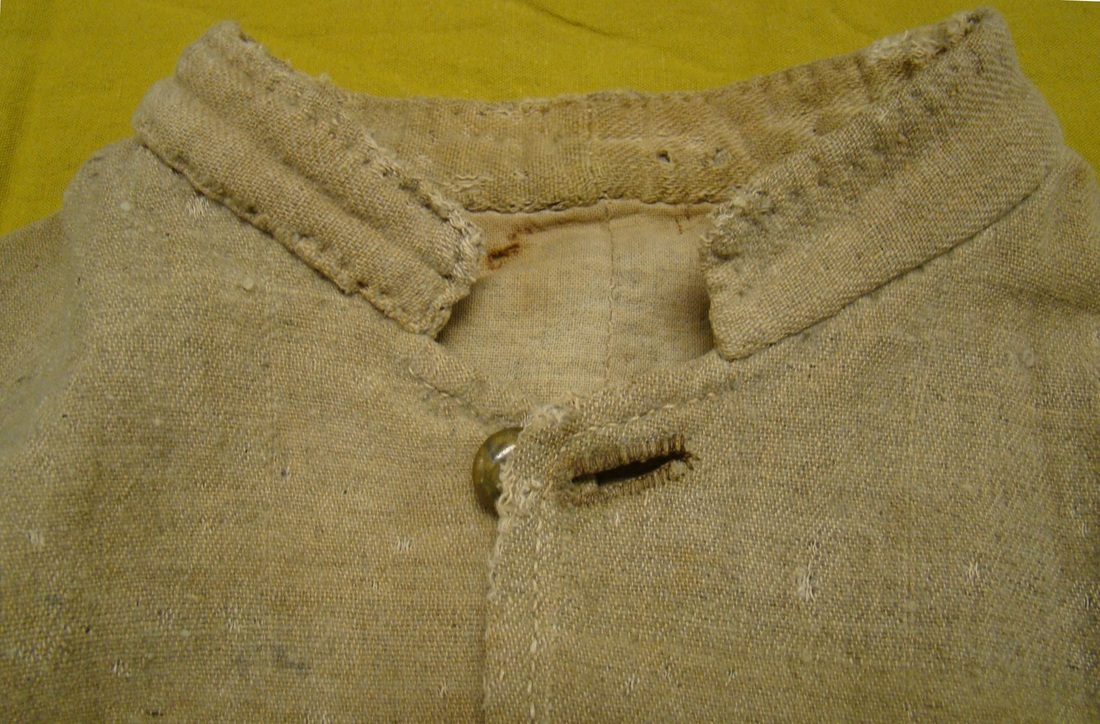
The collar is top-stitched around the top edge with a basting stitch. The right base of the collar may have been repaired after the garment was issued: hence the basting stitches there. The right side, front collar height is one inch; the left side front collar height is 1 1/8 inches; and, the rear seam, inside collar height is 1 3/8 inches.
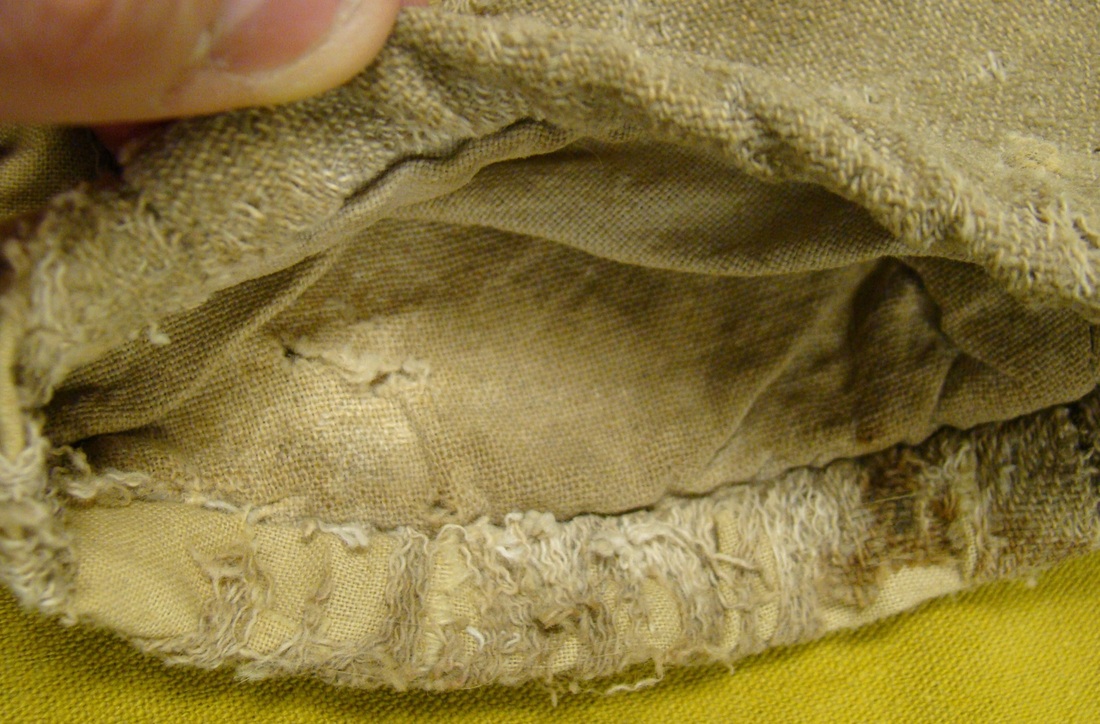
The two images above provide views of the cuff interior. The cuff was closed by folding the jeans inward and tucking the raw edge into the fold, and tucking the lining into the fold of the jeans. The deterioration of the cuff pieces allow further examination of construction details: the lining edges were also folded towards the
seams before being tucked into the fold of the jeans.

It appears that after the jacket was issued, the owner added an interior patch pocket to the right breast lining. The pocket is of a coarser osnaburg than the rest of the lining, and it is whip stitched in place. It is 5 ½ inches wide by 6 inches deep; the opening is turned back 3/8 of an inch with a tucked-in edge.
Grizzard's simple shell jacket embodies many of the characteristics of late-war, Confederate manufactures. Practicality and ease of fabrication are the hall marks of this garment. The number of front buttons has been reduced to five; it came with a single pocket, yet one that was easy to access on the outside; and, the fabric mill dispensed with dying the fill yarn, leaving it natural white to save both time and cost. By the last year of the war, this general design predominated throughout the Western theater of the Confederacy.
In closing, I would like to thank Ray Richey and Gary Hendershott again for their generosity in sharing this jacket with Adolphus Confederate Uniforms and the public. Readers are encouraged to visit Ray Richey's Texas Civil War Museum, and Gary Hendershott’s
website to see some truly amazing historic artifacts.
Readers are reminded that the images and text herein are the exclusive property of Adolphus Confederate Uniforms, are under copyright protection, and may not be copied or published in any form whatsoever.
In closing, I would like to thank Ray Richey and Gary Hendershott again for their generosity in sharing this jacket with Adolphus Confederate Uniforms and the public. Readers are encouraged to visit Ray Richey's Texas Civil War Museum, and Gary Hendershott’s
website to see some truly amazing historic artifacts.
Readers are reminded that the images and text herein are the exclusive property of Adolphus Confederate Uniforms, are under copyright protection, and may not be copied or published in any form whatsoever.
